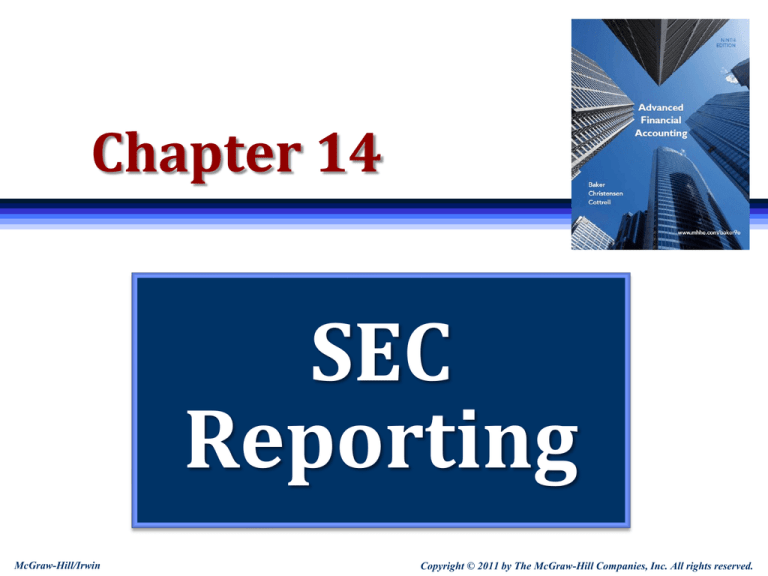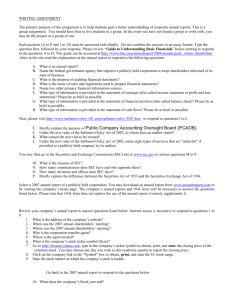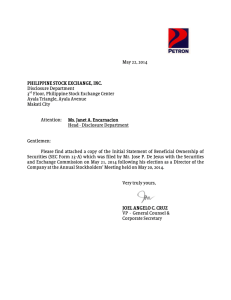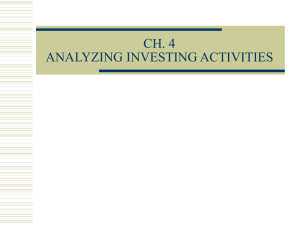
Chapter 14
SEC
Reporting
McGraw-Hill/Irwin
Copyright © 2011 by The McGraw-Hill Companies, Inc. All rights reserved.
Learning Objective 1
Understand the SEC’s
structure and regulatory
authority.
14-2
SEC
The Securities and Exchange Commission
(SEC) is an independent federal agency
created in 1934 responsible for
regulating securities markets
The ability of companies to raise capital
in the stock markets and the high trading
volumes are indications of the SEC’s
success in maintaining an effective
marketplace for companies issuing
securities and for investors seeking
capital investments
14-3
History of Securities Regulation
Thirteenth century – King Edward
establishes a Court of Aldermen to
regulate security trades in London
Eighteenth century – England’s
Parliament passed several acts (the
Bubble Acts), to control questionable
security schemes
1790 – Creation of the New York Stock
Exchange
14-4
History of Securities Regulation
1911 – States began passing what were
called “blue sky laws” to regulate the
offering of securities by companies which
did not have a sound financial base
1920s – Era of heavy stock speculation by
many individuals
The Great Depression
The Federal Securities Acts of 1933 and
1934
14-5
History of Securities Regulation
The Securities Act of 1933
Regulated the initial distribution of security issues by
requiring companies to make “full and fair” disclosure of
their financial affairs before their securities could be
offered to the public
The Securities Exchange Act of 1934
Required all companies whose stocks were traded on a
stock exchange to periodically update their financial
information
Created the Securities and Exchange Commission and
assigned it the responsibility of administering both the
1933 and 1934 acts
14-6
History of Securities Regulation
The SEC has the legal responsibility to
regulate trades of securities and to
determine the types of financial
disclosures that a publicly held company
must make
The SEC’s role is to ensure full and fair
disclosure; it does not guarantee the
investment merits of any security
14-7
EDGAR System
EDGAR (Electronic Data Gathering,
Analysis, and Retrieval)
An electronic filing system developed by the SEC
Under this system, firms electronically file
directly by using computers, facilitating the data
transfer and making public data more quickly
available
14-8
International Harmonization of Accounting
Standards for Public Offerings
The International Accounting Standards
Board (IASB) is working with the
Financial Accounting Standards Board
(FASB) to converge on a uniform set of
accounting and financial reporting
standards that can be used by all
companies seeking financing through any
of the world’s major stock markets,
including those of the United States
14-9
International Harmonization of Accounting
Standards for Public Offerings
In 2007, the SEC published Securities Act
Release No. 33-8879
Under this, financial statements from foreign private
issuers will be accepted by the SEC without
reconciliation to U.S. GAAP, if they are prepared using
IFRSs as issued by the IASB
Securities Act Release No. 33-8831
A Concept Release
If U.S. issuers are allowed to use IFRSs in their filings
with the SEC, multinational U.S. companies operating in
several countries could use just one set of accounting
and financial reporting standards for all of their global
operations
14-10
Securities and Exchange Commission
Organizational structure
Division of Corporation Finance – Develops and
administers the disclosure requirements for the
securities acts and reviews all registration
statements and other issue-oriented disclosures
Division of Enforcement – Directs the SEC’s
enforcement actions
Division of Investment Management – Regulates
investment advisers and investment companies
Division of Market Regulation – Regulates
national securities exchanges, brokers, and
dealers of securities
14-11
Securities and Exchange Commission
Organizational Structure of the SEC
14-12
Securities and Exchange Commission
Laws administered by the SEC
Public Utility Holding Company Act of 1935
Trust Indenture Act of 1939
Investment Company Act of 1940
Investment Advisors Act of 1940
Securities Investor Protection Act of 1970
Sarbanes-Oxley Act of 2002
The SEC is often asked for assistance in the
administration of two other major laws:
Foreign Corrupt Practices Act of 1977
Federal Bankruptcy Acts
14-13
Securities and Exchange Commission
The regulatory structure
Regulation S-X and Regulation S-K, govern the
preparation of financial statements and
associated disclosures made in reports to the
SEC
Regulation S-X presents the rules for preparing
financial statements, footnotes, and the auditor’s
report
Regulation S-K covers all nonfinancial items,
such as management’s discussion and analysis of
the company’s operations and financial position
14-14
Securities and Exchange Commission
The regulatory structure
The Accounting and Auditing Enforcement
Releases (AAERs) present the results of
enforcement actions taken against accountants,
brokers, and other participants in the filing
process
The Staff Accounting Bulletins (SABs) allow the
SEC staff to make announcements on technical
issues with which it is concerned as a result of
reviews of SEC filings
14-15
The Regulatory Structure
14-16
The Regulatory Structure
14-17
Practice Quiz Question #1
Which of the following statements is true
about the SEC?
a. The SEC was created in response to the
Korean War in the mid-1950s.
b. The SEC has the legal responsibility to
regulate trades of securities
c. The SEC’s role is to ensure full and fair
disclosure and it guarantees investments.
d. The SEC is managed directly by the U.S.
Vice President.
e. Staff Accounting Bulletins (SABs) allow
the SEC staff to make announcements
regarding government social events.
14-18
Learning Objective 2
Understand the process of
registering securities within
the SEC.
14-19
Issuing Securities: The Registration Process
Companies wishing to sell debt or stock securities
in interstate offerings to the general public are
generally required by the Securities Act of 1933 to
register those securities with the SEC
The basic financial statements required are:
Two years of balance sheets
Three years of statements of income,
Three years of statements of cash flows
Three years of statements of shareholders’ equity
Prior years’ statements are presented on a comparative
basis with those for the current period
The SEC requires at least five years of selected financial
information presenting key numbers
14-20
Issuing Securities: The Registration Process
A number of types of securities and securities
transactions are exempt from registration:
Commercial paper with a maturity of nine months or less
Intrastate issues in which the securities are offered and sold
only within one state
Securities exchanged by an issuer exclusively with its existing
shareholders with no commission charged
Issuances of securities by governments, banks, savings and
loan associations, farmers, co-ops, and common carriers
regulated by the Interstate Commerce Commission
Securities of nonprofit religious, educational, or charitable
organizations
The antifraud provisions of the securities acts
still apply
14-21
Issuing Securities: The Registration Process
Small issues under the SEC’s Regulation A
for issuances up to $5,000,000 within a
12-month period can be exempt if there is
a notice filed with the SEC and an “offering
circular” containing financial and other
information provided to the persons to
whom the offer is made
Some required disclosures of financial
statements and other financial
information fall under Regulation A
14-22
Issuing Securities: The Registration Process
Regulation D presents three exemptions from
full registration requirements for private
placements:
Rule 504 exempts small issuances up to $1,000,000
within a 12-month period to any number of investors
Rule 505 exempts issuances up to $5,000,000 within a
12-month period
The sales can be made to up to 35 “unaccredited investors”
and to an unlimited number of “accredited investors”
Rule 506 allows private placements of an unlimited
amount of securities and applies, in general, the same
rules of Rule 505 except the maximum of 35
unaccredited investors must be sophisticated investors
14-23
Issuing Securities: The Registration Process
Offering process begins with the selection
of an investment banker (“underwriter”)
Underwriter provides marketing information
and directs the distribution of the securities
The underwriting agreement specifies such
items as the underwriter’s responsibilities and
the final disposition of any unsold securities
14-24
Issuing Securities: The Registration Process
The Registration Statement
The process of public offerings of securities
begins with the preparation of the registration
statement
The company must select one from among
approximately 20 different forms the SEC
currently has for registering securities
The most common:
Form S-1: The most comprehensive registration statement
Form S-2: An abbreviated form for present registrants who
have other publicly traded stock
Form S-3: A brief form available for large, established
registrants whose stock has been trading for several years
14-25
Issuing Securities: The Registration Process
The Registration Statement
Form S-1 has two different levels of disclosure
Part I: “Prospectus,” is intended primarily for
investors
Part II includes more detailed information
The statement must be signed by the principal
executive, financial, and accounting officers, as
well as a majority of the company’s board of
directors
The company then submits its registration
statement to an SEC review by the Division of
Corporation Finance
14-26
Issuing Securities: The Registration Process
SEC review and public offering
Most first-time registrants receive a “customary
review,” which is a thorough examination by the
SEC that may result in:
Acceptance, or
A comment letter specifying the deficiencies that
must be corrected
Established companies that already have stock
widely traded generally are subject to a
summary review or a cursory review
14-27
Issuing Securities: The Registration Process
SEC review and public offering
Once the registration statement becomes
effective, the company may begin selling
securities to the public
This review period is 20 days unless the
company receives a comment letter from the SEC
Between the time the registration statement is
presented to the SEC and its effective date, the
company may issue a preliminary prospectus (a
red herring prospectus), which provides
tentative information to investors about an
upcoming issue
14-28
Issuing Securities: The Registration Process
SEC review and public offering
The company prepares a “tombstone ad” in the
business press to inform investors of the
upcoming offering
The time period between the initial decision to
offer securities and the actual sale may not
exceed 120 days
14-29
Issuing Securities: The Registration Process
Shelf registration rule:
For large, established companies with other
issues of stock already actively traded
These companies may file a registration
statement with the SEC for a stock issue that
may be “brought off the shelf ” and, with the aid
of an underwriter, updated within a very short
time, usually two to three days
14-30
Issuing Securities: The Registration Process
Accountants’ legal liability in the
registration process
Under section 11 of the 1933 act, accountants are
liable for any materially false or misleading
information to the effective date of the registration
statement
The underwriters handling the sale of the securities
often require a “comfort letter” from the registrant’s
public accountants for the period between the filing
date and the effective date
This letter provides additional evidence that the
public accountant has not found any adverse
financial changes since the filing date
14-31
Practice Quiz Question #2
Which of the following is not a step in the
registration process?
a. The company selects and underwriter.
b. The company prepares a registration
statement.
c. The SEC reviews the registration
statement.
d. The SEC’s Chief Accountant signs a
letter of attestation regarding the
offering.
e. The company begins selling securities.
14-32
Learning Objective 3
Understand periodic
reporting requirements.
14-33
Periodic Reporting Requirements
Companies with more than $10 million in
assets and whose securities are held by
more than 500 persons must file annual
and other periodic reports as updates on
their economic activities
The three basic forms used for this
updating are
Form 10-K,
Form 10-Q, and
Form 8-K
14-34
Periodic Reporting Requirements
Form 10-K is the annual filing to the SEC
“Accelerated filers” must file their Form 10-K
within 60 days after the end of the company’s
fiscal year
Small businesses, and others who do not meet
the requirements for an accelerated filer, have
until 90 days after the end of their fiscal years
14-35
Periodic Reporting Requirements
Form 10-K has four parts
Parts I, II, and III include:
The management’s discussion and analysis
The audited financial statements and footnotes
The report by management on the internal
control structure and the assessment of the
effectiveness of those controls
The auditor’s opinion
At least five years of condensed financial
information disclosures
Part IV contains additional schedules and
exhibits
14-36
Periodic Reporting Requirements
Form 10-Q is the quarterly report to the
SEC
Accelerated filers must file a Form 10-Q within
35 days after the end of each of their first three
quarters
Other companies must file within 45 days after
the end of each of their first three quarters
No Form 10-Q is filed for the fourth quarter
because that is when the Form 10-K is filed
14-37
Periodic Reporting Requirements
Form 10-Q has two parts
Part I includes comparative financial statements
prepared in accordance with APB 28
Part II is an update on significant matters
occurring since the last quarter
Form 8-K is used to disclose unscheduled
material events
Companies must file a Form 8-K within four
business days of the occurrence of a “triggering
event”
14-38
Periodic Reporting Requirements
Schedule 13D
Filed by those who acquire a beneficial ownership of
more than 5 percent of a class of registered equity
securities and must be filed within 10 days after such an
acquisition
Beneficial ownership - Directly or indirectly having the
power to vote the shares or investment power to sell the
security
Proxy statements
Materials submitted to shareholders for votes on
corporate matters
In many cases, voting on these matters takes place at the
annual meeting but it may also occur at a special meeting
14-39
Periodic Reporting Requirements
Accountants’ legal liability in periodic
reporting
The 1934 Securities Exchange Act provides for a
limited level of legal exposure from involvement
in the preparation and filing of periodic reports
Civil liability is imposed for filing materially false
or misleading statements
Accountants are provided with due diligence
defences
14-40
Practice Quiz Question #3
Which of the following is not one of the
three required disclosures of publicly
traded companies?
a. Form 10-K.
b. Form 10-Q.
c. Form 8-K.
d. Form 8-Q.
14-41
Learning Objective 4
Understand requirements for
management reporting laws.
14-42
Foreign Corrupt Practices Act of 1977
Congress passed the Foreign Corrupt
Practices Act of 1977 (FCPA) as a major
amendment to the Securities Exchange
Act of 1934
The FCPA has two major sections:
Part I prohibits foreign bribes
Part II requires publicly held companies to
maintain an adequate system of internal control
and accurate records
14-43
Sarbanes-Oxley Act of 2002
Signed into law on July 30, 2002
Gained impetus after the revelations about
accounting and financial mismanagement at
Enron, WorldCom, and others
The legislation (broadly known as SOX) has a
number of major implications for accountants
14-44
Sarbanes-Oxley Act – Major Sections
Title I: Public Company Accounting Oversight Board
Title II: Auditor Independence
Title III: Corporate Responsibility
Title IV: Enhanced Financial Disclosures
Title V: Analyst Conflicts of Interest
Title VI: Commission Resources and Authority
Title VII: Studies and Reports
Title VIII: Corporate and Criminal Fraud Accountability
Title IX: White-Collar Crime Penalty Enhancements
Title X: Sense of Congress Regarding Corporate Tax
Returns
Title XI: Corporate Fraud and Accountability
14-45
Practice Quiz Question #4
Which of the following statements is NOT
true about management reporting laws?
a. The Foreign Corrupt Practices Act of
1977 (FCPA) is a major amendment to
the Securities Exchange Act of 1934.
b. The FCPA prohibits foreign bribes and
requires internal controls.
c. The Sarbanes-Oxley Act of 2002 (SOX)
was enacted due to suspected fraud of
Microsoft Inc. executives.
d. SOX requires regular, detailed internal
control testing.
14-46
Learning Objective 5
Understand disclosure
requirements.
14-47
Disclosure Requirements
Management Discussion and Analysis
MD&A of a company’s financial condition and
results of operations is part of the basic
information package required in all major filings
with the SEC
The items now required in the MD&A are:
liquidity, capital resources, results of operations,
off-balance sheet arrangements, tabular
disclosure of contractual obligations
14-48
Disclosure Requirements
Pro forma disclosures
Essentially “what-if ” financial presentations
often taking the form of summarized financial
statements
They show the effects of major transactions that
occur after the end of the fiscal period or that
have occurred during the year but are not fully
reflected in the company’s historical cost
financial statements
14-49
Practice Quiz Question #5
Which of the following is true about
additional financial disclosures?
a. MD&A stands for “Management Disclosure
and Admissions.”
b. MD&A is required in all major SEC filings.
c. Pro forma disclosures are “what-if ”
financial presentations often taking the
form of summarized financial statements .
d. Pro forma disclosures show the effects of
major transactions that have occurred
during the year but are not reflected in the
financial statements.
14-50
Conclusion
The End
14-51





